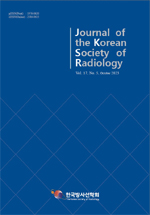
초음파 영상에서의 초고분해능 합성곱 신경망 알고리즘의 시뮬레이션 및 실험 연구
Simulation and Experimental Studies of Super Resolution Convolutional Neural Network Algorithm in Ultrasound Image
- 한국방사선학회
- 한국방사선학회 논문지
- 제17권 제5호
- 2023.10
- 693 - 699 (7 pages)
초음파는 의료분야에서 비파괴적 및 비침습적인 질병 진단에 널리 활용되고 있다. 진단의료영상의 질병 진단 정확도를 향상시키기 위하여 공간 분해능을 향상시키는 것은 매우 중요하다. 본 연구에서는 초음파 영상에서의 초고분해능 합성곱 신경망 알고리즘 (super resolution convolutional neural network, SRCNN)을 모델링하여 적용 가능성을 분석하고자 한다. 연구는 FieldⅡ 시뮬레이션과 open source로 제공되는 임상 간 혈관종 초음파 영상을 사용한 실험 연구로 수행되었다. 제안하는 SRCNN 알고리즘은 저분해능 (low resolution, LR)에서 고분해능 (high resolution)으로 end-to-end 방식의 학습이 적용될 수 있도록 모델링하였다. 시뮬레이션 결과 FieldⅡ 프로그램을 통한 팬텀 영상에서의 반치폭 값은 SRCNN을 사용하였을 때 LR에 비하여 41.01% 향상되는 것을 확인하였다. 또한, 최대신호대잡음비 (peak to signal to noise ratio, PSNR)와 구조적 유사도 지표 (structural similarity index, SSIM)) 평가 결과는 시뮬레이션과 실제 간 혈관종 영상에서 SRCNN이 가장 우수한 값으로 도출되었다. 결론적으로 SRCNN의 초음파 영상에서의 적용 가능성을 증명하였고, 나아가 다양한 진단의료분야에서의 사용이 가능할 것으로 기대한다.
Ultrasound is widely used in the medical field for non-destructive and non-invasive disease diagnosis. In order to improve the disease diagnosis accuracy of diagnostic medical images, improving spatial resolution is a very important factor. In this study, we aim to model the super resolution convolutional neural network (SRCNN) algorithm in ultrasound images and analyze its applicability in the medical diagnostic field. The study was conducted as an experimental study using FieldⅡsimulation and open source clinical liver hemangioma ultrasound imaging. The proposed SRCNN algorithm was modeled so that end-to-end learning can be applied from low resolution (LR) to high resolution. As a result of the simulation, we confirmed that the full width at half maximum in the phantom image using a FieldⅡ program was improved by 41.01% compared to LR when SRCNN was used. In addition, the peak to signal to noise ratio (PSNR) and structural similarity index (SSIM) evaluation results showed that SRCNN had the excellent value in both simulated and real liver hemangioma ultrasound images. In conclusion, the applicability of SRCNN to ultrasound images has been proven, and we expected that proposed algorithm can be used in various diagnostic medical fields.
Ⅰ. INTRODUCTION
Ⅱ. MATERIAL AND METHODS
Ⅲ. RESULT
Ⅳ. DISCUSSION
Ⅴ. CONCLUSION
Reference